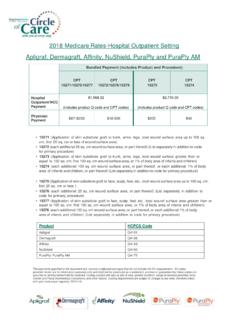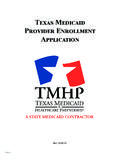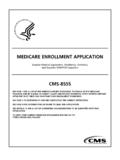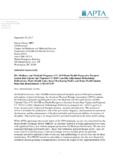Transcription of NGS Medicare Policy Primer - Apligraf
1 NGS Medicare Policy Primer Medicare Jurisdiction (JK & J6) NY, MA, ME, VT, CT, RI, NH, MN, WI & IL Retired skin substitute LCD effective 9/1/16 Indications Apligraf Non-infected partial and full-thickness skin ulcers due to VSU of greater than 1 month duration and which have not adequately responded to conventional ulcer therapy. Full-thickness neuropathic DFU of greater than 3 weeks duration which have not adequately responded to conventional ulcer therapy and which extend through the dermis but without tendon, muscle, capsule or bone exposure. Dermagraft In the treatment of full-thickness diabetic foot ulcers of greater than 6 weeks duration which extend through the dermis but without tendon, muscle, capsule or bone exposure.
2 PuraPly Indicated for the management of wounds including: Partial and full-thickness wounds Venous ulcers Diabetic ulcers Drainage wounds Pressure ulcers Chronic vascular ulcers Trauma wounds (abrasions, lacerations, second-degree burns, skin tears) Surgical wounds (donor sites/grafts, post-Mohs surgery, post-laser surgery, podiatric, wound dehiscence) Disclaimer: This document is for informational purposes only. Use of this information does not guarantee coverage or payment for these services by Medicare or other payors. Physicians and other providers should use independent judgment when selecting codes that most appropriately describe the services provided to a patient.
3 Physicians and hospitals are solely responsible for compliance with Medicare and other payors laws, rules, and requirements. For the full LCD, please refer to PuraPly AM Indicated for the management of wounds as an effective barrier to resist microbial colonization within the dressing and reduce microbes penetrating through the dressing: Partial and full-thickness wounds Pressure ulcers Venous ulcers Diabetic ulcers Chronic vascular ulcers Tunneled/undermined wounds Surgical wounds (donor sites/grafts, post-Mohs surgery, post-laser surgery, podiatric, wound dehiscence) Trauma wounds (abrasions, lacerations, second-degree burns, skin tears) Drainage wounds Affinity Affinity is a fresh ( not dehydrated, not frozen) amniotic membrane allograft consisting of an epithelial layer, basement membrane, stromal layer, and spongy layer.
4 Affinity contains a well preserved extracellular matrix, several types of viable cells native to the tissue, and multiple growth factors, cytokines. Affinity is minimally processed to retain the natural benefits of the tissue and is hypothermically maintained to preserve the structural integrity and viability of the amniotic tissue for 42 days. Affinity provides an optimal environment for the repair and restoration of wound tissue and supports the body s natural ability to heal. Affinity can be applied to a variety of partial- and full-thickness, acute and chronic wounds, including, but not limited to: Diabetic foot ulcers Venous leg ulcers Arterial ulcers Pressure ulcers Surgical wounds Trauma wounds Disclaimer: This document is for informational purposes only.
5 Use of this information does not guarantee coverage or payment for these services by Medicare or other payors. Physicians and other providers should use independent judgment when selecting codes that most appropriately describe the services provided to a patient. Physicians and hospitals are solely responsible for compliance with Medicare and other payors laws, rules, and requirements. For the full LCD, please refer to NuShield NuShield is a sterilized, dehydrated placental allograft membrane containing all of the layers of both the amnion and chorion. NuShield contains an extracellular matrix maintained in its native configuration along with many different growth factors and cytokines present in amniotic tissue.
6 NuShield is minimally processed to take advantage of the tissue s natural biologic and physical properties for ease of use, while preserving the native protein content and may be stored at ambient conditions for up to 5 years. NuShield is intended for homologous use to support the repair, reconstruction and replacement of damaged tissue. NuShield can be applied to a variety of partial- and full-thickness, acute and chronic wounds, including, but not limited to: Diabetic foot ulcers Venous leg ulcers Arterial ulcers Pressure ulcers Surgical wounds Trauma wounds Limitations Apligraf : The safety and effectiveness of Apligraf have not been established for patients receiving greater than 5 device applications Dermagraft: has not been studied in patient receiving greater than 8 device applications Coding HCPCS Codes: Q4101: Apligraf , per square centimeter Q4106.
7 Dermagraft, per square centimeter Q4172: PuraPly, PuraPly Antimicrobial per square centimeter Q4159: Affinity, per square centimeter Q4160: NuShield, per square centimeter Disclaimer: This document is for informational purposes only. Use of this information does not guarantee coverage or payment for these services by Medicare or other payors. Physicians and other providers should use independent judgment when selecting codes that most appropriately describe the services provided to a patient. Physicians and hospitals are solely responsible for compliance with Medicare and other payors laws, rules, and requirements.
8 For the full LCD, please refer to JW Modifier: Effective January 1, 2017 in Physician Office Setting, Place of service 11- claims for discarded drug or biological amount not administered to any patient, shall be submitted using the JW modifier. This modifier, billed on a separate line, will provide payment for the amount of discarded drug or biological. Providers must document the discarded drugs or biologicals in patient's medical record. CPT Codes: Application Codes for Leg, Arm or Trunk: 15271: Application of skin substitute graft to trunk, arms, legs, total wound surface area up to 100 sq cm; first 25 sq cm or less wound surface area 15272: Application of skin substitute graft to trunk, arms, legs, total wound surface area up to 100 sq cm; each additional 25 sq cm wound surface area, or part thereof (List separately in addition to code for primary procedure) 15273: Application of skin substitute graft to trunk, arms, legs, total wound surface area greater than or equal to 100 sq cm.
9 First 100 sq cm wound surface area 15274: Application of skin substitute graft to trunk, arms, legs, total wound surface area greater than or equal to 100 sq cm; each additional 100 sq cm wound surface area, or part thereof (List separately in addition to code for primary procedure) Application Codes for Foot, face, scalp, etc.: 15275: Application of skin substitute graft to face, scalp, eyelids, mouth, neck, ears, orbits, genitalia, hands, feet, and/or multiple digits, total wound surface area up to 100 sq cm; first 25 sq cm or less wound surface area 15276: Application of skin substitute graft to face, scalp, eyelids, mouth, neck, ears, orbits, genitalia, hands, feet, and/or multiple digits, total wound surface area up to 100 sq cm.
10 Each additional 25 sq cm wound surface area, or part thereof (List separately in addition to code for primary procedure) 15277: Application of skin substitute graft to face, scalp, eyelids, mouth, neck, ears, orbits, genitalia, hands, feet, and/or multiple digits, total wound surface area greater than or equal to 100 sq cm; first 100 sq cm wound surface area 15278: Application of skin substitute graft to face, scalp, eyelids, mouth, neck, ears, orbits, genitalia, hands, feet, and/or multiple digits, total wound surface area greater than or equal to 100 sq cm; each additional 100 sq cm wound surface area, or part thereof (List separately in addition to code for primary procedure) Disclaimer: This document is for informational purposes only.









